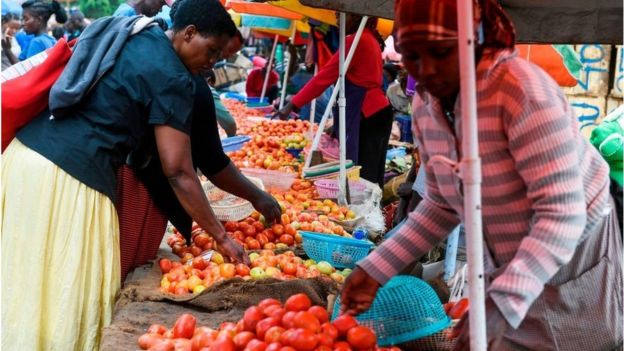Angry Kenyans have been taking to social media to protest about the high cost of living in the country driven by a spike in the cost of basic commodities including food, electricity and fuel.
Using the hashtag #lowerfoodprices, Kenyans have criticised the government for failing to stem the rise in the prices of everyday items which they say has made life unbearable.
In January the overall inflation rate in the country fell slightly for the second straight month – to 5% – but the prices of basic food commodities like maize flour and wheat flour, potatoes, vegetables and fruits continued rising – which may disproportionately impact low- and middle-income households.
Food inflation for the month of January stood at 9%, meaning many Kenyans struggled to put food on the table.
The Kenya National Bureau of Statistics (KNBS) says for poorer households, where food accounts for about 36% of total spending, the burden is even higher.
Many people shared their shopping lists, detailing how prices of basic food items like milk, bread, sugar and maize flour had spiked sharply in recent months, making it difficult for them to afford three meals a day.
But while the frustration on social media was collective, the financial squeeze is more painful on a personal level.
Benandine Munira, a trader in Nairobi’s Toi open-air market, says she is struggling to put food on the table as her monthly household budget cannot buy as much as it could a few months ago.
“The prices of goods have really gone up. We cannot take it any more. A few months ago refilling a 6kg [13lb] cooking gas cylinder was between $5 [£3.50] to $6. Today it’s about $13,” she says.
“Back then, with a shopping budget of $26 you would leave with a box full of goods. Today the same amount gives you just a few items.”


Why have prices been rising?
The increase in the cost of living can be attributed to a combination of external and domestic factors.
Under pressure from the International Monetary Fund (IMF) to raise more revenue, the government has increased taxes on everyday household goods such as cooking gas, fuel and food.
For instance, value added tax (VAT) was not applied to cooking gas for many years but a levy of 16% was imposed in July 2021.
Partly because of the effects of Covid-19, which hit tourism and exports, the Kenyan shilling has been losing value – by about 6% since May 2021 – pushing up the prices of all imported goods.
The pandemic has also disrupted global supply chains, making it more expensive and tedious to access and move goods and services across borders.
Nikhil Hira, a tax expert at Nairobi-based firm Kody Africa LLP, says: “There is no doubt that today the cost of living has spiralled beyond control.
“And it’s difficult particularly for those who live on a daily wage, and without that daily wage cannot eat at night.”
Outside the city, it’s even worse. A prolonged drought in the country’s north has left an estimated 2.8 million people facing severe hunger.
Can the government do anything?
In the short term, the government may be able to bring some respite by lowering VAT on regular household goods like cooking gas, cooking oil and food. But it must develop a fresh tax policy that adapts to changing needs.
The petroleum ministry is already drawing from a subsidy scheme to allow the government to compensate oil marketers for rises in petroleum prices, in order to shield consumers.

The energy ministry has also been implementing a phased 30% reduction in electricity costs since December 2021 in order to cushion consumers.
The issue of price rises is bound to play a big role in August’s general elections.
One of the favourites to succeed President Uhuru Kenyatta, Deputy William Ruto, is promising a food-secure nation.
While on the campaign trail in December, he said: “We will put enough money in agriculture, produce enough food, reduce the cost of seeds and the cost of fertiliser, reduce the cost of food so that we can lower the cost of living in Kenya, so that we can ensure every Kenyan can feed his family.”
While his main rival, Raila Odinga, is pledging a social protection programme targeting about two million unemployed and vulnerable Kenyans, who will receive about $55 a month.
“A nation’s greatness is judged by how it treats its poor and vulnerable,” he said.
But Kenyans should remember that Mr Kenyatta himself made similar promises in 2013, when he launched his presidential campaign: “The scourge of poverty and unemployment still stalks our nation, robbing millions of hope. 70% of our youth in Kenya do not have jobs. We need to create jobs for our youth and securing them will be my priority.”
The World Bank projects that the country’s economy will grow by 5% in 2022, but beyond these headline figures, Kenyans want to feel the growth on a personal level.





























